Table of content
Pork skin jelly, a beloved delicacy in many Asian and European cuisines, is celebrated for its unique gelatinous texture and rich, savory flavor. Often referred to as “pork jelly,” “aspic,” or “pork rind gelatin,” this dish transforms humble ingredients into a culinary masterpiece. However, achieving the ideal consistency—neither too soft nor too rubbery—requires precision, patience, and an understanding of the science behind collagen breakdown. One of the most frequently asked questions by home cooks and aspiring chefs is: How long should I cook pork skin jelly to get it right? This article delves into the factors influencing cooking time, provides a step-by-step guide, and explores the cultural and culinary nuances of this timeless dish.
The Science Behind Pork Skin Jelly
Before diving into cooking times, it’s essential to grasp the biochemical processes at play. Pork skin, rich in collagen, is the star ingredient. Collagen is a structural protein found in connective tissues, bones, and skin. When subjected to heat and moisture, collagen undergoes a transformation called denaturation, breaking down into gelatin. Gelatin, a hydrocolloid, has the remarkable ability to form a gel when cooled, trapping water molecules and creating the signature wobbly texture of pork skin jelly.
The key to perfect jelly lies in balancing two factors:
- Collagen Extraction: Sufficient heat and time to dissolve collagen into gelatin.
- Texture Control: Avoiding overcooking, which can degrade gelatin and result in a runny or brittle texture.
Factors Influencing Cooking Time
Cooking pork skin jelly isn’t a one-size-fits-all process. Several variables affect how long it should simmer:
Thickness and Quality of Pork Skin
- Fresh vs. Dried Skin: Fresh pork skin (often sold as “pork rinds” or “pork cracklings”) cooks faster than dried or salted varieties, which may require rehydration.
- Thickness: Thicker skins (e.g., from the shoulder or belly) need longer cooking to fully break down collagen compared to thinner skins (e.g., from the ear or tail).
Cut Size
- Small Cubes vs. Large Pieces: Smaller pieces expose more surface area to heat, accelerating collagen breakdown. Large chunks may require additional time.
Cooking Temperature
- Simmering vs. Boiling: A gentle simmer (around 85–95°C/185–203°F) preserves gelatin integrity. Boiling can cause rapid evaporation and uneven texture.
- Pressure Cooking: Modern pressure cookers reduce cooking time by 50–70%, but require careful monitoring to prevent over-softening.
Added Ingredients
- Acidic Components: Ingredients like vinegar, wine, or citrus juice can tenderize skin faster but may slightly reduce gelatin yield.
- Aromatics: Onions, garlic, and spices don’t affect cooking time but enhance flavor.
Desired Texture
- Firm Jelly: Requires longer cooking to maximize gelatin extraction.
- Soft Jelly: Shorter cooking preserves some collagen for a softer bite.
Step-by-Step Cooking Guide
Follow this method for classic pork skin jelly, with adjustments for variables like pressure cooking or alternative cuts.
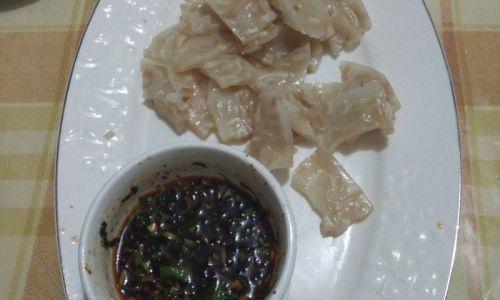
Ingredients
- 1 kg (2.2 lbs) pork skin (preferably fresh, with some fat attached for flavor)
- 2 liters (8.5 cups) water
- 1 onion, quartered
- 2 carrots, roughly chopped
- 2 celery stalks, roughly chopped
- 1 bay leaf
- 5 black peppercorns
- 1 tsp salt (adjust to taste)
Instructions
-
Preparation (15–30 minutes)
- Rinse pork skin under cold water to remove impurities.
- Cut into 5–7 cm (2–3 inch) strips or cubes. Smaller pieces cook faster.
- (Optional) Blanch skin in boiling water for 5 minutes to remove excess fat and impurities. Drain and rinse.
-
Initial Simmer (2–3 hours)
- Place pork skin, water, and vegetables in a large pot.
- Bring to a boil, then reduce heat to a gentle simmer.
- Skim off foam and impurities that rise to the surface.
- Simmer uncovered for 2–3 hours. Stir occasionally to prevent sticking.
-
Testing for Doneness
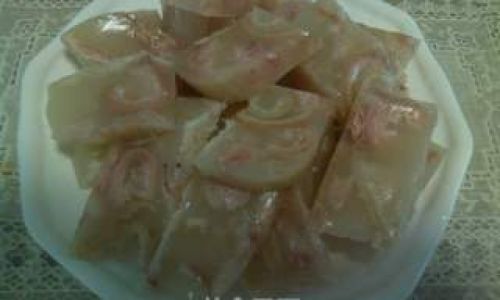
- After 2 hours, check a piece of skin:
- Undercooked: Skin remains tough and opaque; collagen hasn’t fully dissolved.
- Perfect: Skin is translucent and easily breaks apart when pressed.
- Overcooked: Skin disintegrates into mush; gelatin may weaken.
- After 2 hours, check a piece of skin:
-
Straining and Seasoning (30 minutes)
- Remove large solids (skin, vegetables) using a slotted spoon.
- Strain the broth through a fine-mesh sieve or cheesecloth to remove smaller particles.
- Return broth to the pot. Add salt and adjust seasoning.
-
Final Simmer (30–60 minutes)
- Simmer the strained broth for an additional 30–60 minutes to concentrate flavors and gelatin.
- Skim any remaining fat or impurities.
-
Setting the Jelly (4–6 hours)
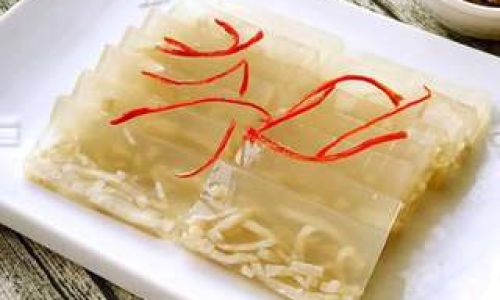
- Pour the hot broth into molds or containers.
- Cool to room temperature, then refrigerate for 4–6 hours (or overnight) until fully set.
Adjusting Cooking Time for Specific Needs
Pressure Cooker Method
- Time: 45–60 minutes on high pressure, followed by natural release.
- Pros: Faster cooking, retains more moisture.
- Cons: Risk of overcooking; monitor closely.
Slow Cooker Method
- Time: 6–8 hours on low heat.
- Pros: Hands-off cooking; deep flavor development.
- Cons: Longer time; requires pre-blanching to avoid cloudiness.
Thick vs. Thin Skin
- Thick Skin (e.g., shoulder): Add 30–60 minutes to simmering time.
- Thin Skin (e.g., ear): Reduce simmering by 30 minutes.
High-Altitude Cooking
- At elevations above 900 meters (3,000 feet), water boils at lower temperatures. Increase cooking time by 10–15% to compensate.
Troubleshooting Common Issues
Jelly Doesn’t Set
- Cause: Insufficient gelatin extraction or too much water.
- Solution:
- Simmer longer to extract more collagen.
- Reduce broth by boiling to concentrate gelatin.
- Add unflavored gelatin powder (1 tsp per 500ml broth) as a backup.
Jelly Is Too Rubbery
- Cause: Overcooking degraded gelatin.
- Solution:
- Use thinner skin cuts next time.
- Add a splash of water when reheating to soften texture.
Cloudy Broth
- Cause: Impurities or fat not skimmed properly.
- Solution:
- Blanch skin before cooking.
- Strain broth through cheesecloth.
Bland Flavor
- Cause: Insufficient seasoning or short simmering.
- Solution:
- Add aromatics (garlic, herbs) during cooking.
- Simmer broth longer to concentrate flavors.
Cultural Variations and Creative Twists
Pork skin jelly transcends borders, with regional adaptations offering endless inspiration:
- Chinese “Pig’s Ear Jelly” (Zhū’ěr Dōng): Flavored with soy sauce, star anise, and chili oil.
- Vietnamese “Thịt Nấu Đông”: Includes pork, eggs, and wood ear mushrooms.
- Eastern European “Kholodets”: Served with horseradish or mustard.
- French “Aspic”: Often molded into decorative shapes with vegetables or meat.
Modern chefs experiment with infusions like smoked paprika, roasted garlic, or even fruit purees for unexpected flavor combinations.
The Role of Fat in Pork Skin Jelly
While fat contributes to flavor, excessive amounts can create a greasy texture. For a balanced jelly:
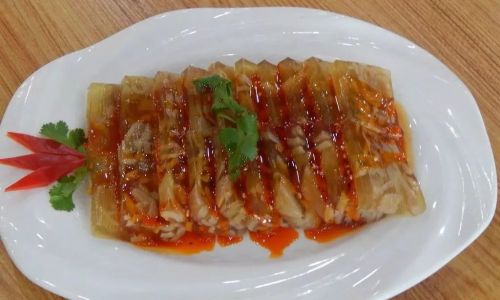
- Leave a thin layer of fat on the skin for richness.
- Skim fat during cooking but retain some for mouthfeel.
- Chill the jelly, then remove congealed fat from the surface before serving.
Sustainability Tip: Reducing Waste
Pork skin jelly is an eco-friendly dish, utilizing a byproduct often discarded by butchers. To minimize waste:
- Save scraps from pork cuts (e.g., roasts) to make jelly.
- Use leftover cooking liquid as a base for soups or stews.
Conclusion: The Art of Patience
Cooking pork skin jelly is a dance between science and intuition. While guidelines provide a framework, mastery comes from practice and observation. Start with the recommended 2–3 hours of simmering, adjust based on your ingredients, and embrace the subtle variations that make each batch unique. Whether enjoyed as a nostalgic family dish or a avant-garde restaurant creation, pork skin jelly rewards the patient cook with a texture that dances on the palate and a flavor that lingers in memory. So, the next time you ask, “How long should I cook this?” remember: the answer lies not just in minutes, but in the alchemy of heat, time, and tradition.
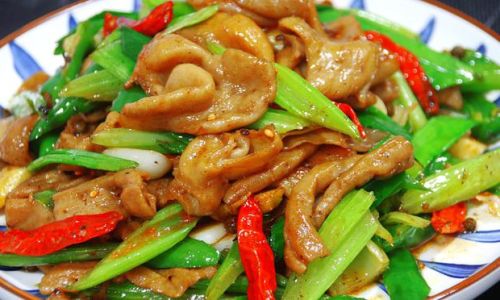
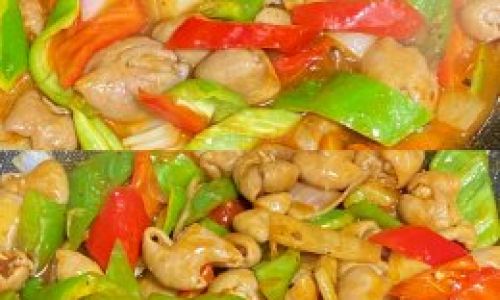
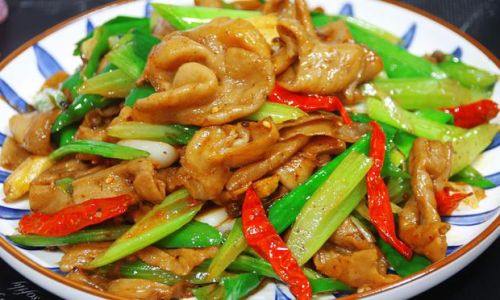
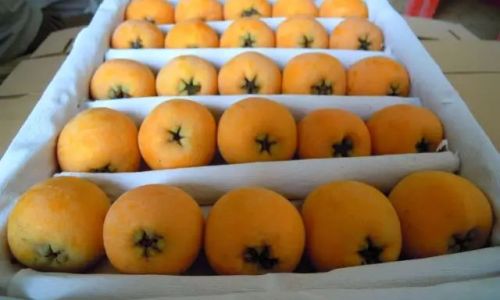


0 comments